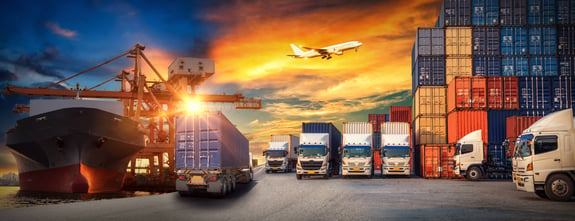Sophisticated digital systems within the transportation and logistics (T&L) industries are attracting cyber attacks like bees to honey. Hackers are targeting valuable customer data stored in digital systems, simultaneously exploiting vulnerabilities in online platforms and mobile devices. Whilst technology and digitisation improve operations, driving efficiency and expanding revenue streams, the inevitable ying and yang direct us to the prevalence of cyber threats and attacks.
All facets from maritime to rail, trucking, logistics providers, and even parcel deliverers have become exposed to unprecedented cyber risks. The consequences of cyber attacks can be severe, leading to costly disruptions and compromised systems. On average, the cost of a cyber security incident in the T&L industry is around £1.15m for large organisations, as reported by Marsh & Mclennan.
Cyber attacks in the transport and logistics industries are on the rise
From high-profile incidents such as the Colonial Pipeline ransomware attack to small-scale disruptions targeting major shippers, there's an air of constant threat. Research indicates cyber attacks on operational technology in the maritime sector alone rose by 900%.
One way to begin to understand the dilemma facing T&L companies is to familiarise yourself with the vulnerabilities they face.
Identifying weaknesses in the transport and logistics industries
The simplest way to understand the vulnerabilities T&L organisations face is to categorise them into three areas:
- Technology
- Regulation
- People and processes
Technology
Every part of the transportation and logistics sector runs the risk of cyber attacks. Take maritime companies, for example. What used to be simple distress-and-safety systems have evolved into complex cloud-based networks like the International Maritime Organisation’s (IMO) e-navigation programme. These networks are prime targets for hackers because they gather, merge, and analyse information from ships in real-time. They track everything from ship locations and cargo details to maintenance issues and environmental data.
The rail industry is facing a similar trend. Traditional wire-based train control and management systems (TCMS) are being replaced by wireless standards like GSM-Railway. This broad network connects trains to railway regulation control centres, facilitating communication and coordination. Moreover, like other mobility providers, transportation and logistics organisations are incorporating vehicle infotainment services and other internet-connected equipment, further expanding the scope of cyber vulnerabilities.
These expanding networks, which connect operational technology (OT) systems with internal IT equipment like servers, PCs, and mobile devices, serve as new avenues for hackers. Unfortunately, the urgency to address cyber threats is often lacking among both OT vendors and T&L companies. Sometimes, OT vendors require potentially vulnerable management interfaces for remote access, control, and troubleshooting. Additionally, the computing systems at T&L organisations are often not updated to meet strict security standards.
Moreover, as transportation and logistics companies forge closer partnerships with suppliers and distributors, their dependence on network connections increases. However, the cyber security protocols maintained by these partners are often lax, leaving T&L organisations unaware of the growing risks within their integrated ecosystems, which is a problem at a base level.
Regulation
While many aspects of the T&L industry are regulated in different regions, there are relatively few rules specifically addressing cyber security. This lack of clear standards has made it challenging for regulators to agree on cybersecurity requirements that companies should adhere to worldwide. Consequently, cyber security investments often don't effectively mitigate overall risks.
However, recognising the potential impact of widespread cyber attacks on global trade and economic stability, regulators are becoming more proactive in demanding improved security measures for company networks. Various regulations, such as the EU’s Network and Information Security (NIS) directive and EN 50126 for railroads, aim to establish minimum cybersecurity standards to safeguard sensitive data and operations, including customer records and shipping information. These measures reflect a growing recognition of the importance of cyber security in maintaining industry resilience and protecting critical assets.
People and processes
One of the biggest vulnerabilities in cyber security is people. Employees who can't spot phishing emails make it easy for hackers to start their attacks. In fact, many cyber breaches happen because of flaws in organisational processes and employee knowledge about cyber threats.
Adding to the problem is a shortage of skilled cyber security professionals. In 2020, there were as many as 4 million unfilled cyber security jobs worldwide. This shortage is especially noticeable in the Asia-Pacific region, where graduates with cyber security qualifications often don't see transport and logistics as attractive career paths. Many perceive cyber security jobs as underpaid and lacking in innovation, which discourages talented individuals from pursuing careers in the field.
To address this issue, T&L organisations need to rethink how they approach cyber security. Instead of treating it as a cost centre, they should invest in better wages, benefits, and opportunities for innovation to attract skilled professionals.
How can transport and logistics industries manage cyber risks?
To effectively mitigate cyber risks, T&L organisations must adopt a multifaceted approach. This includes conducting comprehensive risk assessments to identify potential vulnerabilities and threats within their digital systems. Implementing robust safeguards, such as encryption protocols and access controls, can help protect valuable customer data from cyber attacks. Embracing concepts such as zero-trust architecture, where no user or device is trusted by default, can enhance overall security measures and prevent unauthorized access to sensitive information.
By fostering a culture of cyber security awareness among employees, companies can empower their workforce to recognise and respond to potential threats effectively. Investing in talent development by providing ongoing training and education on cyber security best practices can further strengthen the organisation's defenses against evolving cyber threats. Ultimately, a proactive and holistic approach to cyber security is essential for T&L companies to safeguard their operations and reputation in an increasingly digital world.
As cyber threats continue to escalate, organisations must prioritise resilience and preparedness to safeguard their operations and reputation. At tmc3, we have the frameworks and the experience to help you develop and implement your cyber security and data protection strategies. Let's get a conversation started, and get proactive about addressing your challenges.
%20(1).png?width=290&name=Team%20(5)%20(1).png)


COMMENTS